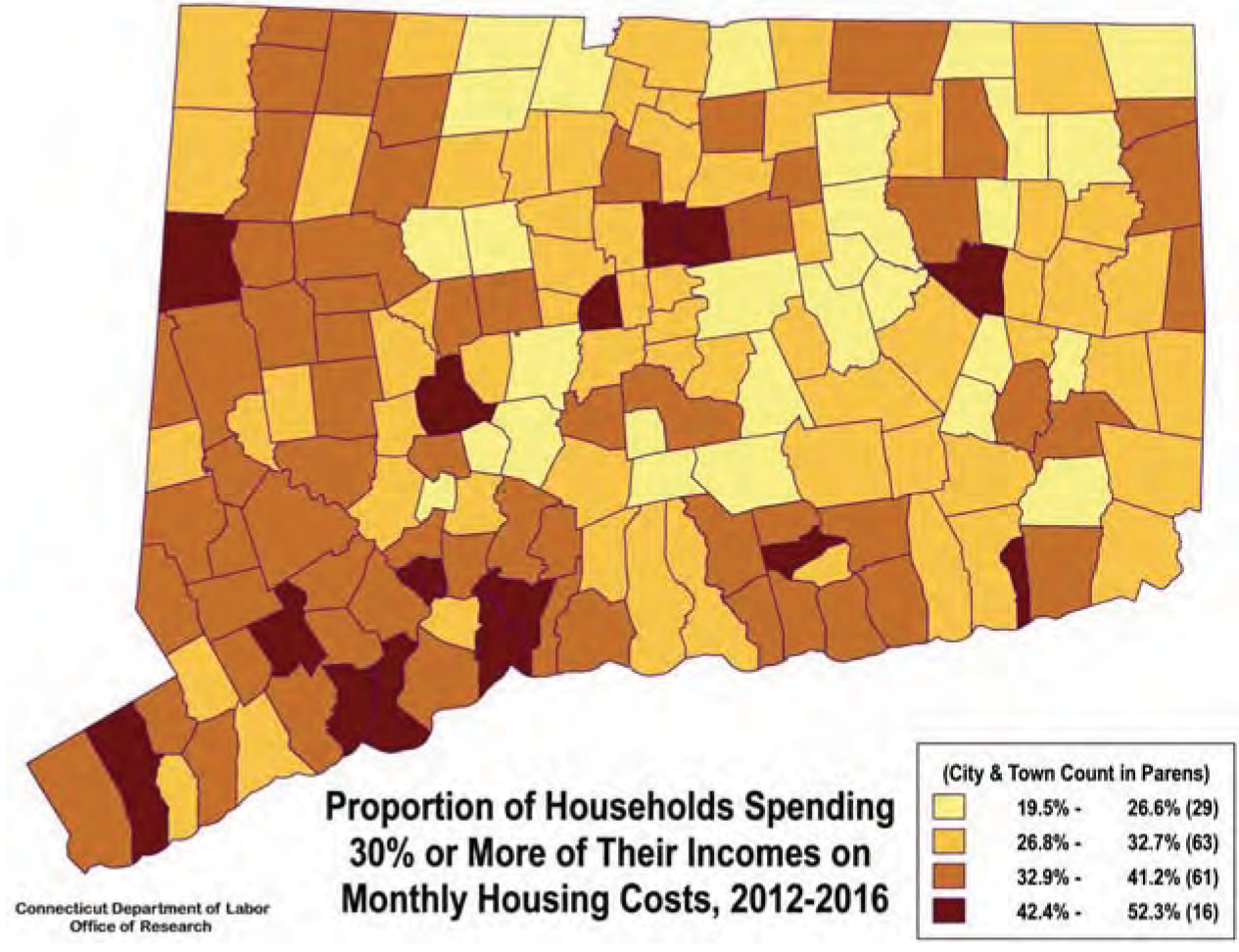

Connecticut's Path to More Affordable Housing
By Al Sylvestre, Research Analyst, DOLSecuring affordable housing in Connecticut's expensive residential market is a significant challenge for the state's workforce. What follows is a brief overview of some of the conundrum's components and some methods land use planners and policy makers employ to smooth the path to more affordable housing.
Challenges
According to the Partnership for Strong Communities, Connecticut has the sixth highest housing cost in the US while nearly a third of the population in 102 of its 169 cities and towns are spending at least 30% of their incomes on housing as shown on the map. As the housing cost burden rises with age, more households headed by persons over age 60 in a state with the sixth oldest population in the nation will find their incomes stretched more thinly. As people with disabilities and those above age 60 re-enter or remain in the workforce longer, access to housing becomes more difficult because:
- Fewer unmodified homes in the northeast are accessible to older residents who must cope with stairs and narrow doorways;
- Half of Connecticut's population older than 60 live in automobile dependent communities;
- Members of the baby boom generation (born 1946-1964) will have difficulty selling their large homes to offspring who cannot afford to buy them; and
- Younger generations are uncertain about home ownership that is inconsistent with their desire to live in smaller homes or move out of state to find better-paying jobs.
As baby boomers live and work longer, mobility impairment becomes an independent-living barrier, as younger people move to densely populated areas and out of state.
For the so-called millennial generation (born 1985-2003), housing affordability challenges are manifested in the same and different ways as their elders'. The 2008-2010 recession slowed household formation raising the question:
- Will millennials buy or rent their elders' homes?
- The Urban Land Institute says 13% of millennials live in central cities and
- Many do not want the expense and inconvenience of car ownership;
Elements of Successful Affordable Housing Production
To overcome affordable housing barriers, planners, developers, and elected leaders of Connecticut's cities and towns must educate their communities about the need for such housing. Community-building consultant David Fink stated that:
- Grand list (the municipality's combined value of real and personal property) losses or stagnation affect 152 of Connecticut's 169 cities and towns;
- Half of the two million people living in New York who were born between 1985 and 2003 will relocate;
- In the town of Fairfield, 86% of its housing is for single family use while 2% of its housing is affordable to people earning less than 80% of area median income (AMI).
In early 2018, the Partnership for Strong Communities brought together planning and development professionals with public officials to discuss the methods they use to increase affordable housing production.
The town of Fairfield's community development office strives to attract affordable housing by making it an economic development goal. Framing the issue as one of local control and oversight promotes discussion and action on affordable housing. This approach helps persuade Fairfield residents that it is in their interest to support affordable housing production. As a result, community groups develop consensus on the town's approach to affordable housing. From those discussions, an inclusionary zoning ordinance proposal requiring a 10% set-aside of affordable units in developments of ten or more residences was written.
The town of Bethel's affordable housing production experience includes working with its housing authority while developers have used provisions of CGS 8-30g 1 to produce affordable units. In addition to establishing an affordable housing trust fund, Bethel won an incentive housing zone (IHZ) grant from the state Office of Policy and Management to plan for a zoning ordinance supporting affordable housing. Town leaders discussed transit oriented development with community participants resulting in a TOD plan calling for both the elderly and young people to benefit from a 20% set-aside of affordable units that included increasing density from 10 to 30 units per acre. Building rental housing is another solution to Bethel's affordable housing shortage.
New Canaan's affordable housing includes 113 recently-built units, 34 (30%) of which are affordable; town officials worked with developers and the housing authority to expand the number from 34 to 40 (35%). The town planning and zoning commission (TPZ) chairman familiarized himself with CGS 8-30g to identify parcels suitable for affordable housing. New Canaan's housing authority used 8-30g provisions to develop affordable housing on its property. Finally, the town established an affordable housing trust funded by a 1% assessment on all town-issued building permits.
Recognition of its affordable housing need led Newtown to encourage developments of greater density in the five villages that comprise the town as its elected leaders persuade town residents that this is path to ensuring a prosperous future for Newtown's younger generations to establish families of their own. To that end, the town commissioned a build-out study to determine Newtown's development potential. The study found that large-lot zoning impedes affordable housing production. As a result, the TPZ met with developers to discuss ways to increase affordable housing production. Newtown then won an IHZ grant to find affordable housing locations and facilitate implementation of its plan of conservation and development (POCD).
Conclusion
While land use planning, legislation, and technical elements of affordable housing development are essential to increasing its availability, community engagement and acceptance from elected officials as well as municipal boards and commissions are essential to more affordable housing production. Education about the benefits of making homes affordable across the income spectrum will overcome concerns about the character and location of such housing. Community engagement with patience and openness brought affordable housing to a variety of communities with more opportunities to come.

